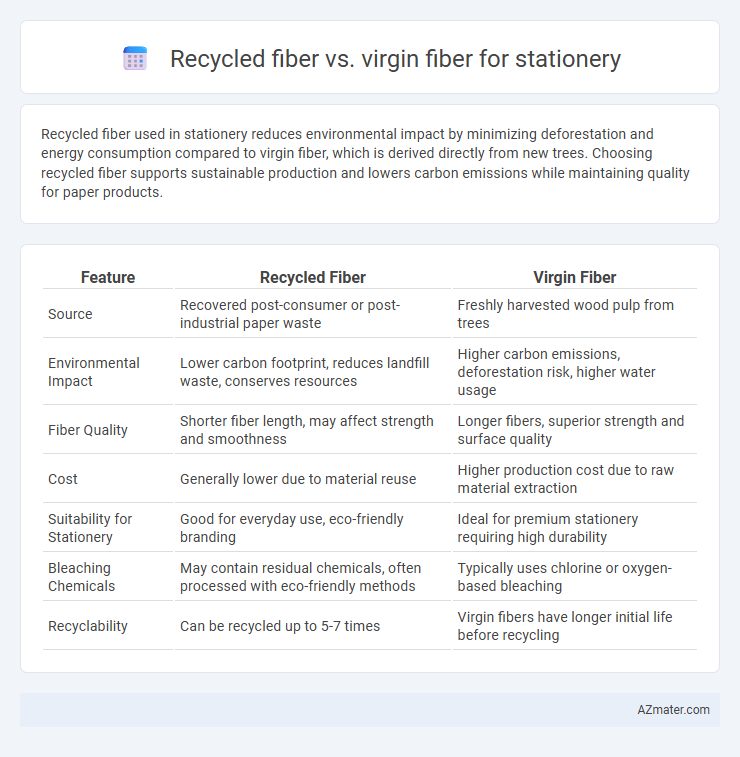Recycled fiber used in stationery reduces environmental impact by minimizing deforestation and energy consumption compared to virgin fiber, which is derived directly from new trees. Choosing recycled fiber supports sustainable production and lowers carbon emissions while maintaining quality for paper products.
Table of Comparison
| Feature | Recycled Fiber | Virgin Fiber |
|---|---|---|
| Source | Recovered post-consumer or post-industrial paper waste | Freshly harvested wood pulp from trees |
| Environmental Impact | Lower carbon footprint, reduces landfill waste, conserves resources | Higher carbon emissions, deforestation risk, higher water usage |
| Fiber Quality | Shorter fiber length, may affect strength and smoothness | Longer fibers, superior strength and surface quality |
| Cost | Generally lower due to material reuse | Higher production cost due to raw material extraction |
| Suitability for Stationery | Good for everyday use, eco-friendly branding | Ideal for premium stationery requiring high durability |
| Bleaching Chemicals | May contain residual chemicals, often processed with eco-friendly methods | Typically uses chlorine or oxygen-based bleaching |
| Recyclability | Can be recycled up to 5-7 times | Virgin fibers have longer initial life before recycling |
Introduction: Understanding Recycled vs. Virgin Fiber
Recycled fiber in stationery products is derived from post-consumer or post-industrial paper waste, offering an eco-friendly alternative by reducing landfill waste and conserving natural resources. Virgin fiber, sourced directly from freshly cut trees, provides higher strength and brightness, making it ideal for premium stationery that demands superior quality and durability. Choosing between recycled and virgin fiber involves balancing environmental impact with performance requirements in stationery production.
Environmental Impact of Fiber Choices
Recycled fiber significantly reduces environmental impact by lowering energy consumption and water usage compared to virgin fiber production. The use of recycled fiber in stationery cuts down on deforestation and decreases greenhouse gas emissions associated with pulp processing. Virgin fiber, while providing higher durability, demands intensive resource extraction and contributes to habitat loss, making recycled fiber a more sustainable option for eco-friendly stationery manufacturing.
Production Process of Recycled Fiber
Recycled fiber in stationery production is derived from post-consumer paper waste that undergoes sorting, deinking, and pulping to remove contaminants and inks. This process significantly reduces water and energy consumption compared to virgin fiber production, as it repurposes existing materials instead of harvesting new wood pulp. The recycled fiber production also minimizes greenhouse gas emissions and deforestation, promoting sustainable paper manufacturing.
Manufacturing Virgin Fiber: An Overview
Manufacturing virgin fiber for stationery involves processing raw wood pulp derived primarily from softwood or hardwood trees, ensuring high strength and brightness in the final product. This fiber offers superior durability and uniformity compared to recycled fiber, which can degrade in quality with each reuse. Virgin fiber production requires significant natural resources and energy but results in premium-quality paper ideal for high-grade stationery applications.
Quality and Performance in Stationery Applications
Recycled fiber in stationery applications often exhibits lower brightness and strength compared to virgin fiber, impacting the smoothness and durability of writing surfaces. Virgin fiber provides superior opacity and resilience, essential for high-quality printing and consistent performance in notebooks and office paper. Choosing virgin fiber ensures better ink absorption and minimal feathering, enhancing the overall writing experience and longevity of stationery products.
Cost Comparison: Recycled vs. Virgin Fiber
Recycled fiber generally costs 20-40% less than virgin fiber due to lower raw material and energy expenses in production. While virgin fiber ensures higher strength and brightness, recycled fiber offers a cost-effective option for stationery manufacturing with growing quality improvements. Businesses prioritize recycled fiber to reduce environmental impact and operational costs, benefiting from sustainable market demand and potential tax incentives.
Sustainability and Certifications
Recycled fiber in stationery products significantly reduces environmental impact by conserving natural resources and lowering greenhouse gas emissions compared to virgin fiber sourced directly from trees. Certified certifications such as FSC Recycled and the Global Recycled Standard (GRS) guarantee responsible sourcing and processing of recycled fiber, ensuring sustainability and traceability. Choosing recycled fiber stationery supports circular economy principles and meets eco-conscious consumer demand while maintaining quality and durability.
Market Trends and Consumer Preferences
The stationery market shows a growing preference for recycled fiber due to increasing environmental awareness and sustainability trends, driving demand for eco-friendly products. Virgin fiber remains favored for premium stationery brands seeking superior strength and print quality, sustaining its market share in high-end segments. Consumer preferences reveal a shift towards transparency and ethical sourcing, with recycled fiber products gaining traction among millennials and Gen Z buyers focused on reducing carbon footprints.
Challenges and Limitations of Each Fiber Type
Recycled fiber in stationery often faces challenges such as lower strength and durability compared to virgin fiber, limiting its suitability for high-quality or heavy-use products. Virgin fiber offers superior brightness, consistency, and printability, but poses environmental concerns due to higher resource consumption and deforestation. Both fiber types also contend with cost implications, where virgin fiber production involves higher raw material expenses, while recycled fiber requires advanced processing to remove contaminants and maintain quality.
Future Outlook for Sustainable Stationery
Recycled fiber in stationery production significantly reduces environmental impact by lowering raw material consumption and decreasing greenhouse gas emissions compared to virgin fiber. Advances in recycling technology and increasing consumer demand for eco-friendly products drive the expansion of recycled fiber usage in sustainable stationery. The future outlook emphasizes innovation in fiber processing and circular economy models to enhance durability, quality, and cost-effectiveness, positioning recycled fiber as the preferred choice for environmentally conscious stationery brands.

Infographic: Recycled fiber vs Virgin fiber for Stationery
 azmater.com
azmater.com